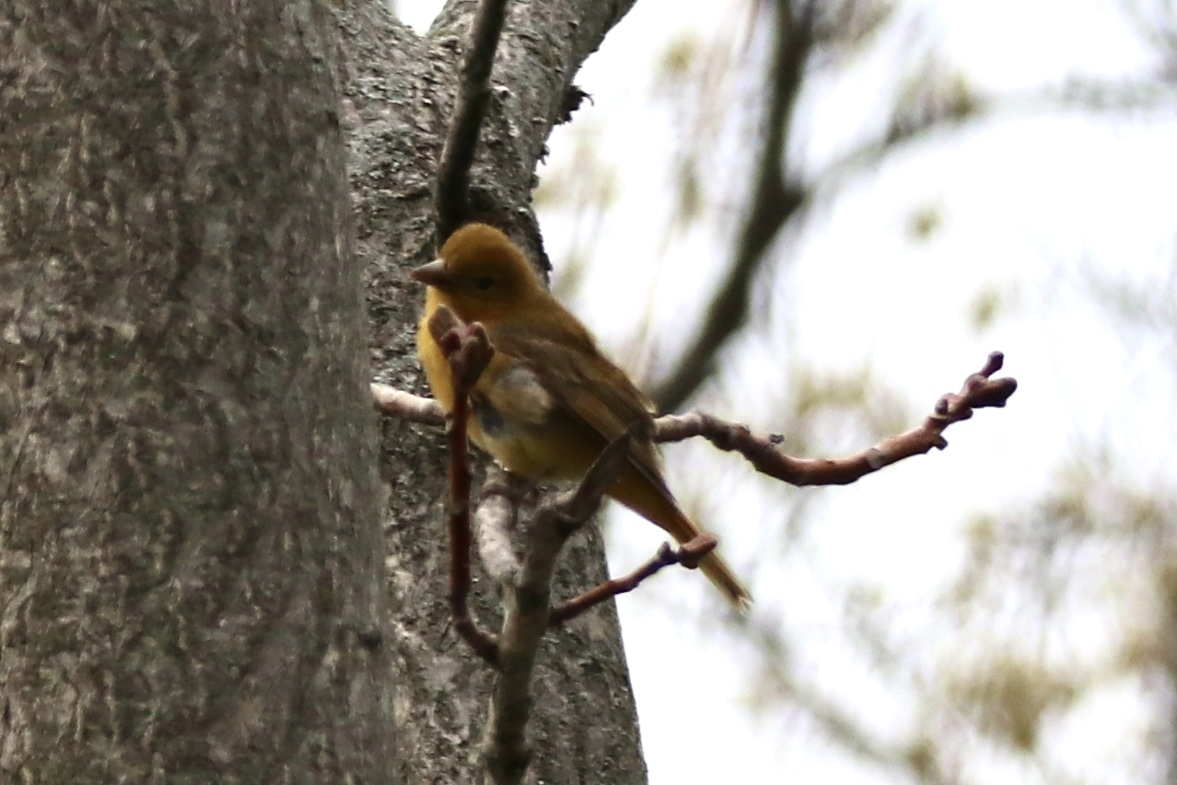Once we left Point Pelee National Park, we migrated east to Rondeau Provincial Park and their Festival of Flight. It may not have the prestige of Pelee, but it is no less birdy and is a much more relaxed and quiet way to do Spring Migration. Plus the Blenheim Sewage Lagoons are close by and we made that our first stop, where we saw a Solitary Sandpiper and a lovely near-breeding plumage Wilson’s Phalarope.
Another new year bird was a Prairie Warbler, which we side street at the north end of the park, after running into another birder who told us about seeing it.
Perhaps the most exciting species I saw at Rondeau, for me, and for many another birder, was a pair of Summer Tanagers. I have seen a few in the US, but never in Canada. This species is one of the more coveted spring migrants, since they are few and far between. Seeing two in the same stand of trees, a young male and female, was such fun. One of the other birders, Michele, who I’ve run into at Long Point, said she had died and gone to heaven, seeing her first Summer Tanager. As a bonus, there was a Scarlet Tanager hanging out with them. Extra thanks to Mark Deabreu for helping me when I saw him photographing a bird at the side of the road. I quickly parked my car and grabbed my gear so I wouldn’t miss species 348 for the year and 429 for my Canada Life List
Then there was the report of a White-winged Dove in Oakville. That was certainly unexpected, and good news, since the resident one in Rondeau didn’t show this spring. I raced over and hung out in the rain with some other birders until it made an appearance.
There was also a failed chase for a Hepatic Tanager. Sue and I were on our last day in Rondeau, when the report came in. We had one more night there, so decided to get up early and head home so I could chase the bird. We did make good time and I had dropped off Sue by 9am and headed to Oakville. I got there at 10:30 and the last the bird had been seen was an hour earlier. It was never seen again. I was, as my old friend, Blue Jays radio broadcaster Tom Cheek, often said, “a day late and a dollar short.” I did, however make good use of the time birding there and was able to count my first Golden-winged Warbler of the year, another one I had missed in Point Pelee and Rondeau.
With most of migration season coming to an end, it was time to head further east, to the Kawartha Lakes. The Carden Alvar, located in Kirkfield, Ontario is an important bird and biodiversity area in Ontario. It is a unique grassland habitat for Ontario and summer home to many grassland species, including the Upland Sandpiper, Bobolink, Sedge Wren, and the endangered eastern subspecies of the Loggerhead Shrike.
My main goals for birding the Carden Alvar were Yellow Rail and Upland Sandpiper. I got the latter but not the former. I spent one late night and one early morning listening for the elusive Yellow Rail, but no calls. I did see the Upland Sandpiper on Wylie Rd as soon as I arrived and that night also got my first American Bittern of the year. I heard them long before even seeing one and expected that was how it was going to be. But as it was getting dark, at least half a dozen bittern flew out of the Sedge Wren Marsh and flew off to parts unknown for the night. I left the area the next day, with a year total of 354 species.
Splish-splash!
American Bittern, Night Flight:
Though not new for the year, I did stop in Hamilton on my way to Carden, to see a breeding plumage Red-throated Loon, a rare sight here in Southern Ontario. I caught it early in the morning, in the rain, not quite ready to start his day.














No comments:
Post a Comment